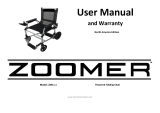Page is loading ...

CONFOCAL APPLICATION LETTER
reSOLUTION
No.46, March 2014
FRAP with TCS SP8 Resonant Scanner

2
Permanent eye and skin damage from laser radiation
Skin and eye damage can occur while using lasers if safety precautions are not
taken. Pay particular attention to the laser safety.
WARNING
Observe the user manual
Follow the safety notes and instructions in the user manual.
General Safety Notes
The system and LAS AF may only be used by persons who have been trained in the use of the system and
about the potential hazards of laser radiation.

Fast FRAP experiments need a sufficient number of mea-
surement points for meaningful interpretation and fitting
analysis. To study very fast translocational processes, the
use of a resonant scanner (RS) is preferred. The advantage
in using FRAP with the RS is that statistics are much better
in experiments that require fast acquisition: If the half time
of recovery is about 0.5 sec you may have only about 3 to 4
data points using the conventional scanner, whereas with
the resonant scanner you can get about 20 data points.
As a consequence, the time to apply the needed laser pow-
er is too short to bleach the region of interest efficiently,
as the following numbers show: The resonant scanner ac-
quires the images 20 times faster than the conventional
scanner. The pixel dwell time in a 512 format at 400 Hz
is about 1.4 µsec (0.4 µsec @1400 Hz) whereas the pixel
dwell time at 8000 Hz is about 0.072 µsec (0.048 µsec @
12 KHz). Comparing a typical FRAP experiment with 1400
Hz vs. 8000 Hz, there is approximately a factor of 5.5 (8 @
12 KHz) less time to deliver the light to the ROI.
To compensate for the very short pixel time more laser
power can be applied. But in almost all standard FRAP
experiments which are performed with the conventional
scanner, full laser power is already applied during the
bleach interval. Hence alternative adjustments are needed.
There are two variables affecting the effective light dose in
the region of interest besides the actual laser power: The
first is the zoom factor of the scanner and the second is the
fill factor of the back aperture of the given objective.
Effect of Zoom In
Fig. 1 shows a FRAP experiment performed with a 63x
lens at 1400 Hz and a circular ROI with a diameter of about
5µm. The zoom is increased from zoom 6 to zoom 30 to
match the field of view to the 5 µm ROI for bleaching. A
zoom factor of 5 delivers about 25 more power per area.
With the conventional scanner, the full effect of Zoom In
can be used. In the case of the resonant scanner, one has
to take into consideration that the resonant x scanner can-
not zoom in and out very fast. This is the reason why the
Zoom In for the x scanner is blocked in the FRAP wizard. In
consequence, even the maximum available laser power is
often insufficient to bleach effectively. To compensate for
the x scanner’s inability to zoom fast enough we introduced
the FRAP Zoomer for the SP8. The FRAP Zoomer uses the
y scanner for zooming in, while the x scanner retains its
scanning angle. Thus, Zoom In can be applied for bleaching
within FRAP wizard and RS at least for one dimension.
FRAP with TCS SP8
Resonant Scanner
Fig. 1 The diagram illustrates how the combination of ROI with zoom delivers more light to the ROI.
3reSOLUTION – FRAP WITH TCS SP8 RESONANT SCANNER

Impact of the fill factor of the back aperture of
the objective
To compensate for the low bleach efficiency caused by very
fast scanning it is helpful to change the fill factor of the
back aperture of the objective. This can be done by retract-
ing the beam expander optics (FRAP Booster) within the
FRAP wizard. In the first step the beam expander can be
retracted for the whole FRAP sequence (Fig.2 ).
If this option is active, the beam expander is retracted from
the beam path. As a result, the back aperture of the objec-
tive is not completely filled with light anymore: The amount
of light is the same but concentrated to a spot in the center,
and about 2 to 5 times more light is available, depending on
the objective (Fig. 3 – 5).
4
Fig. 2 User interface showing how to retract the beam expander (switch on the FRAP Booster) in the “Setup” step.
Fig. 3 The diagram illustrates how the pupil of the objective is filled in yellow, beam expander
in position. The red color shows the more concentrated light with the retracted beam ex-
pander (FRAP Booster active).
Fig. 4 Maximum projection of an xzy scan after beam park, Chroma fluorescent slide. Left: without
FRAP Booster. Right: with FRAP Booster

Fig. 5 Left: without FRAP Booster. Right: with FRAP Booster. The same laser settings were used for both images . GFP-Tubulin in HeLa cells, EMBL Heidelberg.
5reSOLUTION – FRAP WITH TCS SP8 RESONANT SCANNER
Fig. 6 FRAP experiment without FRAP Booster, without FRAP Zoomer. The red line indicates the
bleach pulse.
Fig. 7 FRAP experiment without FRAP Booster, with FRAP Zoomer. The red line indicates the bleach
interval
Fig. 8 FRAP experiment with FRAP Booster and with FRAP Zoomer. The red line indicates the
bleach interval.
sec
sec
interval
sec
interval
interval
Fig. 6 to 8 is showing the results of FRAP experiments with the resonant scanner.
Fig. 6 Without FRAP booster, without FRAP Zoomer
Fig. 7 Without FRAP booster, with FRAP Zoomer
Fig. 8 With FRAP Booster and with FRAP Zoomer
HeLa cells with free YFP were used for the experiments. The FRAP series were
taken with a 40x 1.1 lens and zoom factor of 8 was used during the whole ex-
periment. The frame rate was about 36 fps, the bleaching time about 200 msec.
If you need to bleach even faster, you may use all Ar-laser lines for bleaching.
It can be summarized that during FRAP experiments with RS it may happen that
the time to apply the needed laser power is too short to bleach the region of
interest efficiently. Then appropriate adjustments are needed to concentrate the
available amount of light to a smaller area: The best bleaching results can be
achieved by combining the FRAP Zoomer and the FRAP Booster.

6
Your notes

7reSOLUTION – FRAP WITH TCS SP8 RESONANT SCANNER
Your notes

Leica Microsystems – an international company with a strong network
of worldwide customer services:
Leica Microsystems operates globally in three divisions, where we rank
with the market leaders.
LIFE SCIENCE DIVISION
The Leica Microsystems Life Science Division supports the imaging
needs of the scientific community with advanced innovation and
technical expertise for the visualization, measurement, and analysis
of microstructures. Our strong focus on understanding scientific
applications puts Leica Microsystems’ customers at the leading edge
of science.
INDUSTRY DIVISION
The Leica Microsystems Industry Division’s focus is to support
customers’ pursuit of the highest quality end result. Leica Microsystems
provide the best and most innovative imaging systems to see, measure,
and analyze the microstructures in routine and research industrial
applications, materials science, quality control, forensic science inves-
tigation, and educational applications.
MEDICAL DIVISION
The Leica Microsystems Medical Division’s focus is to partner with
and support surgeons and their care of patients with the highest-quality,
most innovative surgical microscope technology today and into the
future.
The statement by Ernst Leitz in 1907, “With the User, For the User,” describes the fruitful collaboration with end users and driving force of
innovation at Leica Microsystems. We have developed five brand values to live up to this tradition: Pioneering, High-end Quality, Team Spirit,
Dedication to Science, and Continuous Improvement. For us, living up to these values means: Living up to Life.
Active worldwide Tel. Fax
Australia North Ryde +61 2 8870 3500 2 9878 1055
Austria Vienna +43 1 486 80 50 0 1 486 80 50 30
Belgium Diegem +32 2 790 98 50 2 790 98 68
Canada Concord/Ontario +1 800 248 0123 847 405 0164
Denmark Ballerup +45 4454 0101 4454 0111
France Nanterre Cedex +33 811 000 664 1 56 05 23 23
Germany Wetzlar +49 64 41 29 40 00 64 41 29 41 55
Italy Milan +39 02 574 861 02 574 03392
Japan Tokyo +81 3 5421 2800 3 5421 2896
Korea Seoul +82 2 514 65 43 2 514 65 48
Netherlands Rijswijk +31 70 4132 100 70 4132 109
People’s Rep. of China Hong Kong +852 2564 6699 2564 4163
Shanghai +86 21 6387 6606 21 6387 6698
Portugal Lisbon +351 21 388 9112 21 385 4668
Singapore +65 6779 7823 6773 0628
Spain Barcelona +34 93 494 95 30 93 494 95 32
Sweden Kista +46 8 625 45 45 8 625 45 10
Switzerland Heerbrugg +41 71 726 34 34 71 726 34 44
United Kingdom Milton Keynes +44 800 298 2344 1908 246312
USA Buffalo Grove/lllinois +1 800 248 0123 847 405 0164
www.leica-microsystems.com
Order no.: English 1593104033 Copyright © by Leica Microsystems CMS GmbH,
Wetzlar, Germany, 2013. Subject to modifications. LEICA and the Leica Logo are registered
trademarks of Leica Microsystems IR GmbH.
/

